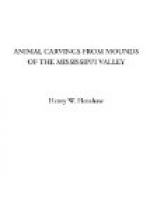[Illustration: Fig. 24.—Woodpecker, from Squier and Davis.]
The heads shown in Fig. 25, which the authors assert “was probably intended to represent the eagle” and “are far superior in point of finish, spirit, and truthfulness to any miniature carving, ancient or modern, which have fallen under the notice of the authors,” cannot be identified further than to say they are raptorial birds of some sort, probably not eagles but hawks.
Fig. 26 (Fig. 180 from Squier and Davis), according to the authors, “certainly represents the rattlesnake.” It certainly represents a snake, but there is no hint in it of the peculiarities of the rattlesnake; which, indeed, it would be difficult to portray in a rude carving like this without showing the rattle. This is done in another carving, Fig. 196.
[Illustration: Fig. 25.—“Eagle,” from Squier and Davis.]
The extraordinary terms of praise bestowed by the authors on the heads of the hawks just alluded to, as well as on many other of the sculptured animals, suggest the question whether the illustrations given in the Ancient Monuments afford any adequate idea of the beauty and artistic excellence asserted for the carvings, and so whether they are fair objects for criticism. While of course for the purpose of this paper an examination of the originals would have been preferable, yet, in as much as the Smithsonian Institution contains casts which attest the general accuracy of the drawings given, and, as the illustrations by other authors afford no higher idea of their artistic execution, it would seem that any criticism applicable to these illustrations must in the main apply to the originals. With reference to the casts in the Smithsonian collection it may be stated that Dr. Rau, who had abundant opportunity to acquaint himself with the originals while in the possession of Mr. Davis, informs the writer that they accurately represent the carvings, and for purposes of study are practically as good as the originals. The latter are, as is well known, in the Blackmore Museum, England.
[Illustration: Fig. 26.—“Rattlesnake,” from Squier and Davis.]
Without going into further detail the matter may be summed up as follows: Of forty-five of the animal carvings, including a few of clay, which are figured in Squier and Davis’s work, eleven are left unnamed by the authors as not being recognizable; nineteen are identified correctly, in a general way, as of a wolf, bear, heron, toad, &c.; sixteen are demonstrably wrongly identified, leaving but five of which the species is correctly given.
From this showing it appears that either the above authors’ zoological knowledge was faulty in the extreme, or else the mound sculptors’ ability in animal carving has been amazingly overestimated. However just the first supposition may be, the last is certainly true.




